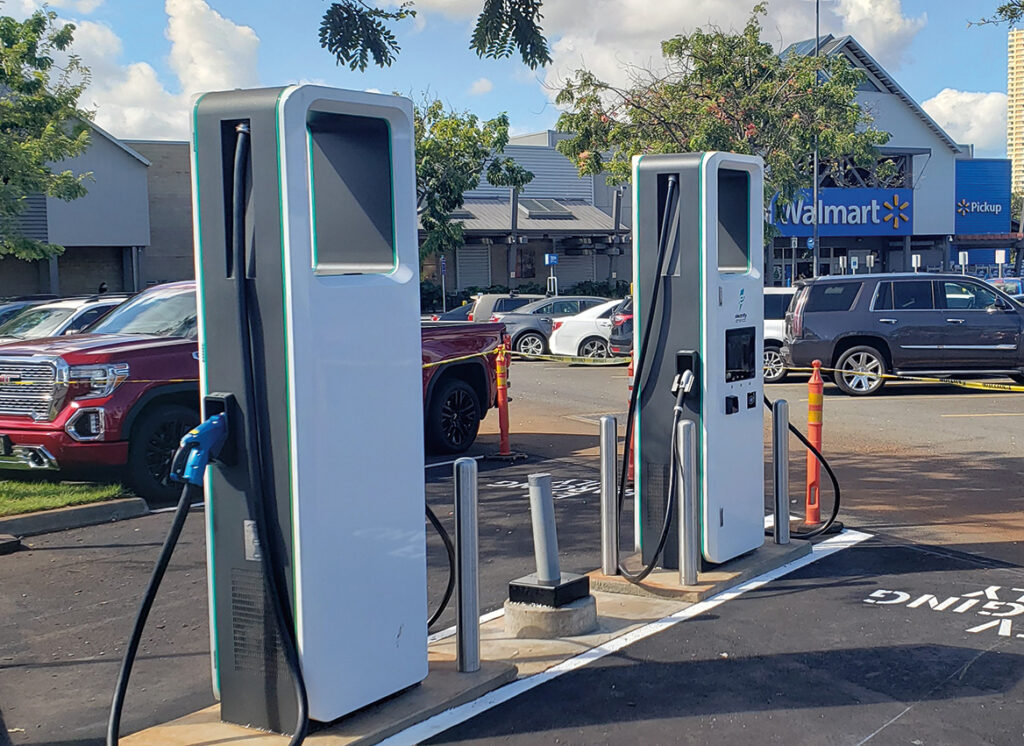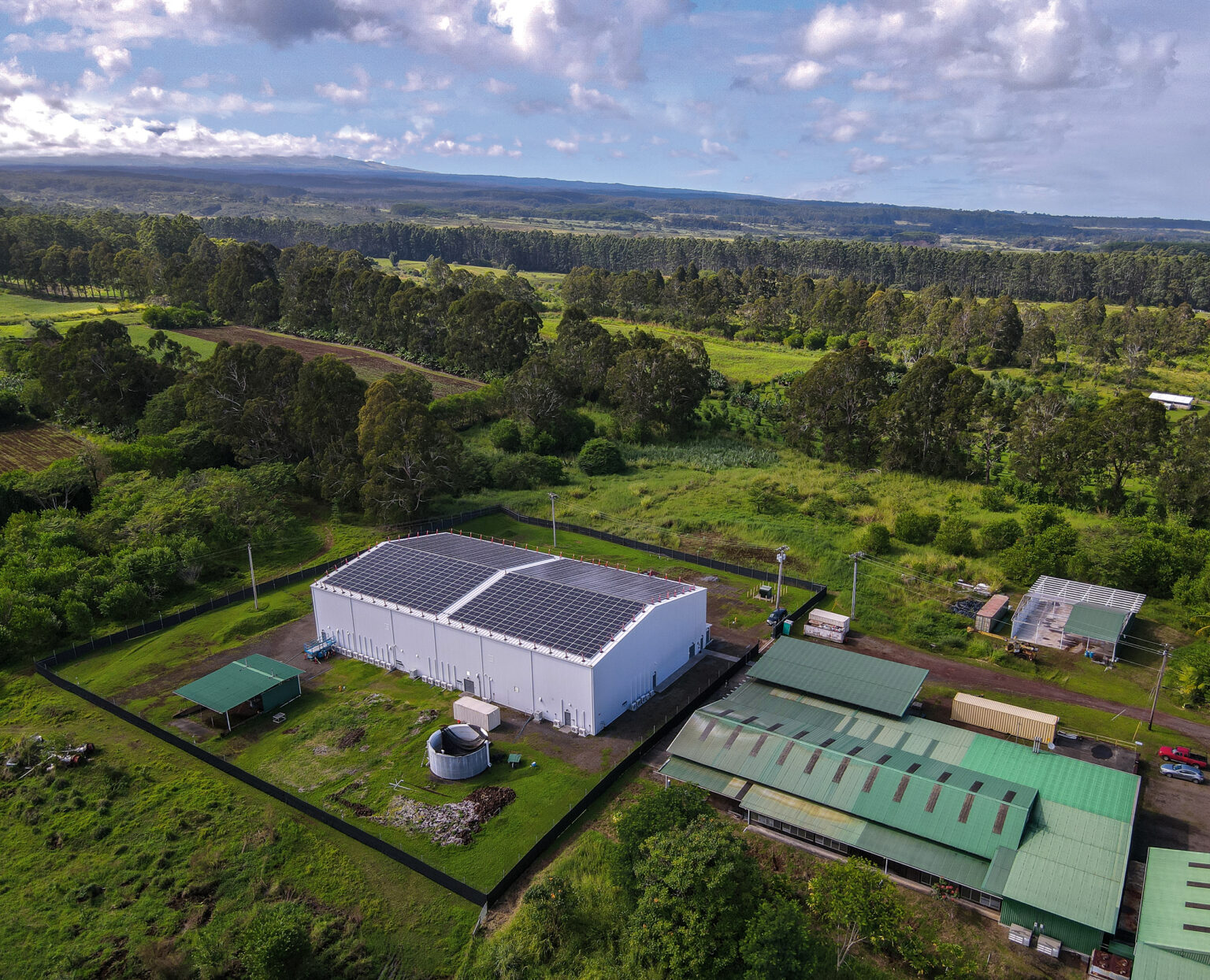Hawaii’s mandate that all power be generated by clean energy in 2045 is spurring significant new energy initiatives and projects in 2022.
One is Kapolei Energy Storage, the largest energy storage project in the state. KES, supported by Hawaiian Electric, will provide 185 megawatt/565 MWh of power when it comes online as scheduled this year.
Other initiatives, such as Hawaiian Electric’s Community-Based Renewable Energy (CBRE) program, are expanding the state’s clean energy options and Hawaii’s solar energy market.
Once the Public Utilities Commission green-lights CBRE, Hawaiian Electric will administer the program’s shared solar phase, states Jim Kelly, Hawaiian Electric vice president of government and community relations and corporate communications, in Trade Media Hui’s 2022 Construction Industry Guide.
Shared solar, Kelly says, “is designed to give renters and apartment dwellers, as well as small businesses and organizations, the chance to save money and be part of the solar movement. Customers unable to put solar on their own roofs can reduce their monthly electric bills by purchasing a portion of a solar project on their island.”
Hawaiian Electric’s Climate Change Action Plan, established in November, will retire at least six fossil-fuel units and gradually replace others with renewable resources for a total of at least 1 gigawatt in clean energy by 2030.
More private rooftop solar—50,000 more systems by 2030—is a critical part of the Plan. To increase rooftop solar, Kelly says, Hawaiian Electric offers programs including “Quick Connect, which allows speedier interconnection of rooftop solar systems, and Battery Bonus, which offers customers a cash incentive to add energy storage to a rooftop system.”



Seizing the Day
Hawaii Pacific Solar, Savio Solar Power Solutions, Greenpath Technologies, Sunspear Energy and other Hawaii energy contractors and developers are already moving forward.
Hawaii Pacific Solar (HPS) is currently contracted for Hawaii Department of Education Heat Abatement Maintenance projects on Oahu, Maui and Kauai. HPS is repairing and maintaining off-grid air conditioning photovoltaic (PV) systems with various storage (battery) technology.
“In 2016 Gov. Ige signed a bill to cool classrooms in Hawaii using PV-powered AC systems backed up with batteries,” says Bob Johnston, Hawaii Pacific Solar president and CEO. “Over the past several years many of these systems failed or became inoperable. Due to the sheer volume of sites, the state used different engineering firms and contractors for design and installation, thereby using several different storage technologies. Hawaii Pacific Solar was contracted to troubleshoot and repair these systems and grid-tie when required.”
HPS technicians provided expertise in differing storage technologies for vendors including Tesla, BMZ, Sunverge, Outback/Simpliphi and Pika. “Hawaii Pacific Solar, through its dedicated operations and maintenance team, is able to identify problems, repair systems by re-energizing the batteries or if necessary, replacing them under existing warranties,” Johnston says. “In some cases where repair is not feasible the systems are grid-tied to the electric grid. This (HDOE) rehabilitation program has been ongoing since 2020 and is expected to continue through 2023.”
Savio Solar Power Solutions, which is aiming to reshape Hawaii’s energy market, is moving ahead on its first solar projects as it prepares to bid into Hawaiian Electric’s approval process.
“We are not changing how solar farms work, we are only changing how they are owned,” says Ali Andrews, CEO of Shake Energy Collaborative, a member of the Savio project team.
Savio Solar, Andrews says, “is for local people.” Local residents are included “from the design of the project, which local residents will have the opportunity to co-design, to the installation of the project, which local companies will be contracted to build. Once the project is built, local homes and businesses can buy a unit of the project through (Hawaiian Electric’s) CBRE program to receive a credit on their utility bill proportional to the energy their unit produced.
“We are still in the design phase of the project,” Andrews says. “Since the announcement in June at the Waikele site near the Waikele Storage Park, we have identified a second site in Maʻili for a second community-owned solar project.”
Waikele is currently expected to offer 4.5 MW of AC solar and four hours of battery storage, and to provide 10 GWh per year (equal to 1,500 houses). Maʻili is currently expected to offer 8 MW of AC solar and four hours of battery storage, and to provide 18.5 GWh per year (equal to more than 3,000 houses).
In addition to Savio Solar Power Solutions as project developer and Shake Energy Collaborative as community design facilitator, the project team includes RevoluSun (solar installation) and Revamp Engineering Inc. (design and engineering).
Andrews says the team has “received applications from local residents to serve on our community design advisory board, and will begin meetings with the board in January. … We will design these two projects in 2022, (and anticipate) a proposal due date in Spring 2022.”

Contracts are expected to be awarded in Fall 2022, with construction to start in 2024 and solar operation in 2025.
“We will also seek to include as many local contractors in the installation of this project and future projects,” Andrews says, adding that the team expects to build several more solar facilities statewide. “This is a solar project for local people,” she emphasizes, “and partnering with local businesses is a big part of that goal.”
Greenpath Technologies’ goal on its current Big Island project is similarly far-reaching. “Greenpath is installing solar and battery systems as a PPA arrangement to help the state municipal to reduce its energy cost across multiple sites within the Department of Water,” says Matsu Thornton, Greenpath Technologies president. “Each site was evaluated and the system sized to bring the highest benefit to the customer and PPA owner.”
Greenpath’s engineering team has considerable background in data analysis and simulation, Thornton says. So “load profiles were generated using data gathered and simulations were run in order to analyze system performance in order to develop designs that were best suited to meet customer needs.” The project’s planned energy output is 286 kW. Greenpath expects to wrap in March, Thornton says, and to mount “similarly sized energy projects starting early this year, hopefully beginning with the Manoa Innovation Center, the University of Hawaii Bachman Hall and Ho Farms installations.”
Also expanding solar energy’s horizons, Sunspear Energy completed a dual on-site solar/hydroelectric power system for Big Island Grown (BIG) in April last year. BIG, a state-of-the-art medical cannabis-growing facility, is harnessing hydroelectric power from nearby Wai‘a‘ma Stream. Sunspear installed REC Alpha Series 440W solar panels to provide BIG with power during its daytime operations.
Sunspear’s system will generate 345,000 kilowatt hours of clean energy per year, offsetting 30 percent of the facility’s overall electricity use. This is expected to decrease BIG’s electric bill by an estimated $85,000 in the first year alone.
“We are very proud of this solar solution,” says Jeff Kaemmerlen, Sunspear Energy CEO. “The amount of fossil fuel needed to power an operation of this size and scope is particularly high. Now with the duality of hydro power and solar it is a very sustainable venture.”

Greenpath Technologies is installing a 286 kW solar and battery system as a PPA arrangement across multiple sites within the Big Island’s Department of Water. PHOTO COURTESY GREENPATH TECHNOLOGIES INC.
Looking to Tomorrow
As shown by Hawaii Pacific Solar’s revamp of varied storage technologies, Greenpath’s data analytics and Sunspear’s dual energy project, upcoming energy projects “will require expertise in fields beyond just the installation of photovoltaic systems,” says Johnston of HPS. “Solar contractors must be able to install and repair varying storage technologies and, like HPS, expand to related fields.
“To meet Hawaii’s renewable energy goals,” Johnston says, “contractors will need to expand their knowledge base to include other renewable energy capabilities.”




